In Photos: Tomb of the Maccabees Possibly Found
Archaeologists working at a site in Judea, in what is now southern Israel, say they may have found the location of the Tomb of the Maccabees, where leaders of a band of Jewish rebels from the second century B.C. were buried. Here's a look at the site and excavated remains. [Read the full story on the Maccabee Site]
Horbat Ha-Gardi
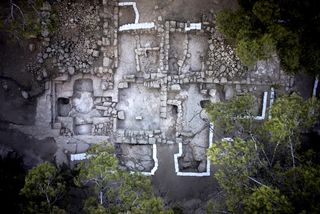
The excavations at Horbat Ha-Gardi in Israel are seen in this bird's-eye view. Archaeologists at the Israel Antiquities Authority recently launched a re-exploration of this site, which was last closely studied nearly 150 years ago. At the time, a debate raged over whether this site might be the long-lost Tomb of the Maccabees, a family of Jewish rebel leaders who wrested control of Judea from the Seleucid Empire in the 2nd Century B.C.
The Maccabees founded the Hasmonean dynasty, which ruled independently or under the banner of Rome until Herod ascended the throne in 37 B.C. (Photo Credit: Skyview Company, courtesy Israel Antiquities Authority)
Magical oil

Archaeologists among the stones at Horbat Ha-Gardi, which may hold the ruins of the Tomb of the Maccabees. The Maccabees rebelled against the Hellenistic Seleucid Empire when the ruler of that Empire outlawed Jewish law and rituals and desecrated the Second Temple in Jeruselum. The reclamation of the Temple is the basis of the Jewish holiday of Hanukkah. According to the Talmud, priests needed to burn holy olive oil continuously to cleanse the Temple, but could only find enough to burn for one night. That flask, however, miraculously burned for eight nights, enough time for the victorious Jews to get more oil to fuel the flame. (Photo Credit: Israel Antiquities Authority)
Maccabee royal tomb
Sign up for the Live Science daily newsletter now
Get the world’s most fascinating discoveries delivered straight to your inbox.
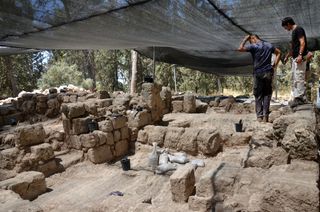
Historical sources describe the Maccabee royal tomb as built with fine stone and sporting pyramid-shaped roofs. Archaeologists in the 1800s were convinced they had found the tomb at Horbat Ha-Gardi, but continued excavations revealed mosaics with crosses on them in the burial chamber floors. Those crosses suggested that the site was built in the early days of Christianity, not 200 years before. However, it's possible that early Christians believed the site to be the burial place of the Maccabees and built the memorial over it. (Photo Credit: Israel Antiquities Authority)
Mysteries remain
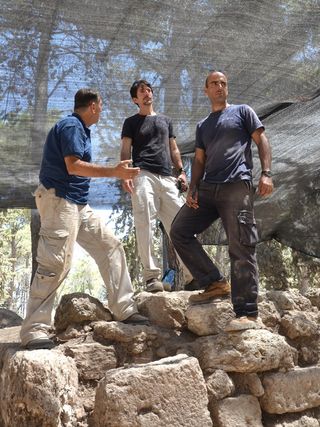
Archaeologists discuss the excavations at Horbat Ha-Gardi. The Israel Antiquities Authority funded the new archaeological research, but more will be needed to determine when the structures were built, and for what purpose. (Photo Credit: Israel Antiquities Authority)
Burial chamber mosaics
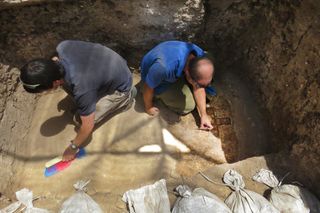
Archaeologists and volunteers gingerly uncover the mosaics on the burial chamber floors at the Horbat Ha-Gardi tomb. These crosses point to an early Christian origin for the site, but no one knows who was buried here. Archaeologists also found large stone pillars, a courtyard in front of the tomb and other buildings. (Photo Credit: Dan Shachar, courtesy of the Israel Antiquities Authority)
Archaeological work
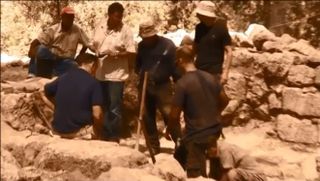
Local volunteers from nearby Modin'in and Hevel Modi'in help archaeologists excavate the Horbat Ha-Gardi site. The site has been looted in the past, according to excavation directors Amit Re'em and Dan Shachar, and some stones were removed to construct local dwellings. More excavations will be needed to determine who built this tomb, and why. (Photo Credit: EYECON, courtesy of the Israel Antiquities Authority)
Follow Stephanie Pappas on Twitter and Google+. Follow us @livescience, Facebook & Google+.

Stephanie Pappas is a contributing writer for Live Science, covering topics ranging from geoscience to archaeology to the human brain and behavior. She was previously a senior writer for Live Science but is now a freelancer based in Denver, Colorado, and regularly contributes to Scientific American and The Monitor, the monthly magazine of the American Psychological Association. Stephanie received a bachelor's degree in psychology from the University of South Carolina and a graduate certificate in science communication from the University of California, Santa Cruz.
Most Popular

